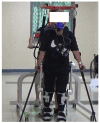Cardiorespiratory Responses to 10 Weeks of Exoskeleton-Assisted Overground Walking Training in Chronic Nonambulatory Patients with Spinal Cord Injury
- PMID: 34372258
- PMCID: PMC8347087
- DOI: 10.3390/s21155022
Cardiorespiratory Responses to 10 Weeks of Exoskeleton-Assisted Overground Walking Training in Chronic Nonambulatory Patients with Spinal Cord Injury
Abstract
Exercise intensity of exoskeleton-assisted walking in patients with spinal cord injury (SCI) has been reported as moderate. However, the cardiorespiratory responses to long-term exoskeleton-assisted walking have not been sufficiently investigated. We investigated the cardiorespiratory responses to 10 weeks of exoskeleton-assisted walking training in patients with SCI. Chronic nonambulatory patients with SCI were recruited from an outpatient clinic. Walking training with an exoskeleton was conducted three times per week for 10 weeks. Oxygen consumption and heart rate (HR) were measured during a 6-min walking test at pre-, mid-, and post-training. Exercise intensity was determined according to the metabolic equivalent of tasks (METs) for SCI and HR relative to the HR reserve (%HRR). Walking efficiency was calculated as oxygen consumption divided by walking speed. The exercise intensity according to the METs (both peak and average) corresponded to moderate physical activity and did not change after training. The %HRR demonstrated a moderate (peak %HRR) and light (average %HRR) exercise intensity level, and the average %HRR significantly decreased at post-training compared with mid-training (31.6 ± 8.9% to 24.3 ± 7.3%, p = 0.013). Walking efficiency progressively improved after training. Walking with an exoskeleton for 10 weeks may affect the cardiorespiratory system in chronic patients with SCI.
Keywords: exoskeleton; heart rate; oxygen consumption; spinal cord injury; walking.
Conflict of interest statement
As employees of the R&D division of Hyundai Motor Company, D.J. Hyun, S. Park, J. Yoon, and H. Lim have received salary support from Hyundai Motor Company. The other authors have no conflict of interest.
Figures


Similar articles
-
Acute Cardiorespiratory and Metabolic Responses During Exoskeleton-Assisted Walking Overground Among Persons with Chronic Spinal Cord Injury.Top Spinal Cord Inj Rehabil. 2015 Spring;21(2):122-32. doi: 10.1310/sci2102-122. Epub 2015 Apr 12. Top Spinal Cord Inj Rehabil. 2015. PMID: 26364281 Free PMC article.
-
Cardiorespiratory demand and rate of perceived exertion during overground walking with a robotic exoskeleton in long-term manual wheelchair users with chronic spinal cord injury: A cross-sectional study.Ann Phys Rehabil Med. 2018 Jul;61(4):215-223. doi: 10.1016/j.rehab.2017.12.008. Epub 2018 Jan 31. Ann Phys Rehabil Med. 2018. PMID: 29371106
-
Effect of robotic gait training on cardiorespiratory system in incomplete spinal cord injury.J Rehabil Res Dev. 2013;50(10):1411-22. doi: 10.1682/JRRD.2012.10.0186. J Rehabil Res Dev. 2013. PMID: 24699976 Clinical Trial.
-
The effects of robot assisted gait training on temporal-spatial characteristics of people with spinal cord injuries: A systematic review.J Spinal Cord Med. 2018 Sep;41(5):529-543. doi: 10.1080/10790268.2018.1426236. Epub 2018 Feb 5. J Spinal Cord Med. 2018. PMID: 29400988 Free PMC article.
-
Gait robot-assisted rehabilitation in persons with spinal cord injury: A scoping review.NeuroRehabilitation. 2022;51(4):609-647. doi: 10.3233/NRE-220061. NeuroRehabilitation. 2022. PMID: 36502343
Cited by
-
Osteopenia in a Mouse Model of Spinal Cord Injury: Effects of Age, Sex and Motor Function.Biology (Basel). 2022 Jan 26;11(2):189. doi: 10.3390/biology11020189. Biology (Basel). 2022. PMID: 35205056 Free PMC article.
-
Comparing walking with knee-ankle-foot orthoses and a knee-powered exoskeleton after spinal cord injury: a randomized, crossover clinical trial.Sci Rep. 2022 Nov 9;12(1):19150. doi: 10.1038/s41598-022-23556-4. Sci Rep. 2022. PMID: 36351989 Free PMC article. Clinical Trial.
-
Exoskeleton Training and Trans-Spinal Stimulation for Physical Activity Enhancement After Spinal Cord Injury (EXTra-SCI): An Exploratory Study.Front Rehabil Sci. 2022 Jan;2:789422. doi: 10.3389/fresc.2021.789422. Epub 2022 Jan 4. Front Rehabil Sci. 2022. PMID: 35169770 Free PMC article.
-
A systematic review of the determinants of implementation of a locomotor training program using a powered exoskeleton for individuals with a spinal cord injury.Clin Rehabil. 2023 Aug;37(8):1119-1138. doi: 10.1177/02692155231164092. Epub 2023 Apr 10. Clin Rehabil. 2023. PMID: 37036438 Free PMC article.
-
Physical activity of community-dwelling adults with traumatic spinal cord injuries in the Cape Metropole.S Afr J Physiother. 2025 Jun 13;81(1):2147. doi: 10.4102/sajp.v81i1.2147. eCollection 2025. S Afr J Physiother. 2025. PMID: 40612928 Free PMC article.
References
MeSH terms
Grants and funding
LinkOut - more resources
Full Text Sources
Medical

